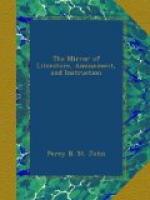We sailed up the Essequibo for a hundred miles in a small schooner of thirty tons, and occasionally took to canoes or coorials to visit the creeks. We then went up a part of the Mazaroony river, and saw also the unexplored Coioony: these three rivers join their waters about one hundred miles from the mouth of the Essequibo. In sailing or paddling up the stream, the breadth is so great, and the wooded islands so numerous, that it appears as if we navigated a large lake. The Dutch in former times had cotton, indigo, and cocoa estates up the Essequibo, beyond their capital Kykoveral, on an island at the forks or junction of the three rivers. Now, beyond the islands at the mouth of the Essequibo there are no estates, and the mighty forest has obliterated all traces of former cultivation. Solitude and silence are on either hand, not a vestige of the dwellings of the Hollanders being to be seen; and only occasionally in struggling through the entangled brushwood one stumbles over a marble tombstone brought from the shores of the Zuyderzee.
At every turn of the river we discovered objects of great interest. The dense and nearly impenetrable forest itself occupied our chief attention; magnificent trees, altogether new to us, were anchored to the ground by bush-rope, convolvuli, and parasitical plants of every variety. The flowers of these cause the woods to appear as if hung with garlands. Pre-eminent above the others was the towering and majestic Mora, its trunk spread out into buttresses; on its top would be seen the king of the vultures expanding his immense wings to dry after the dews of night. The very peculiar and romantic cry of the bell-bird, or campanero, would be heard at intervals; it is white, about the size of a pigeon, with a leathery excrescence on its forehead, and the sound which it produces in the lone woods is like that of a convent-bell tolling.
A crash of the reeds and brushwood on the river’s bank would be followed by a tapir, the western elephant, coming down to drink and to roll himself in the mud; and the manati or river-cow would lift its black head and small piercing eye above the water to graze on the leaves of the coridore tree. They are shot from a stage fixed in the water, with branches of their favourite food hanging from it; one of twenty-two cwt. was killed not long ago. High up the river, where the alluvium of the estuary is changed for white sandstone, with occasionally black oxide of manganese, the fish are of delicious flavour; among others, the pacoo, near the Falls or Rapids, which is flat, twenty inches long, and weighs four pounds; it feeds on the seed of the arum arborescens, in devouring which the Indians shoot it with their arrows: of similar genus are the cartuback, waboory, and amah.




